Investing.com - The U.S. dollar trimmed losses against its Canadian counterpart on Monday, after the release of downbeat Canadian wholesale sales data, although a surge in oil prices still supported demand for the commodity-linked Canadian currency.
USD/CAD eased off 1.3177, the session low, to hit 1.3220 during early U.S. trade, steady for the day.
The pair was likely to find support at 1.3006, Friday's low and a one-month low and resistance at 1.3260, the high of September 16.
Statistics Canada reported on Monday that wholesale sales were flat in July, compared to expectations for a 0.8% increase, after a 1.3% gain the previous month.
But the Canadian dollar remained supported by rising oil prices. Crude oil futures for October delivery were up 2.62% at $46.21 at the open of U.S. trading.
Meanwhile, the greenback regained strength after the U.S. central bank left short-term interest rates unchanged last Thursday, amid concerns over soft inflation and the effects of recent market volatility on the U.S. economy.
The Fed said it wanted to see "some further improvement in the labor market," and be "reasonably confident" that inflation will increase before hiking rates.
While the decision was not completely unexpected the Fed’s concerns over the uncertain outlook for global growth rattled financial markets and pressured the dollar lower.
The loonie was higher against the euro, with EUR/CAD retreating 0.58% to 1.4858.
Sentiment on the single currency was fragile after European Central Bank Chief Economist Peter Praet reiterated Saturday that the bank is prepared to enlarge its monetary stimulus program if necessary to combat risks from global economic turbulence.
Earlier this month the ECB cut its forecasts for growth and inflation and indicated that its trillion-euro bond-buying program could be scaled up.
Elsewhere in the euro zone, Alexis Tsipras was set to form a new government in Greece after his left-wing Syriza party won a second general election in less than nine months.
